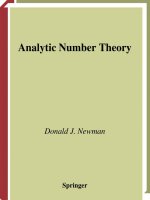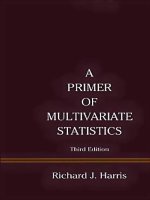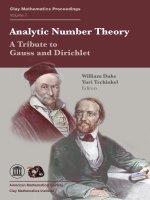A primer of analytic number theory
Bạn đang xem bản rút gọn của tài liệu. Xem và tải ngay bản đầy đủ của tài liệu tại đây (2.58 MB, 399 trang )
This page intentionhally left blank
A PRIMER OF ANALYTIC NUMBER THEORY
This undergraduate introduction to analytic number theory develops analytic
skills in the course of a study of ancient questions on polygonal numbers,
perfect numbers, and amicable pairs. The question of how the primes are
distributed among all integers is central in analytic number theory. This distribution is determined by the Riemann zeta function, and Riemann’s work
shows how it is connected to the zeros of his function and the significance of
the Riemann Hypothesis.
Starting from a traditional calculus course and assuming no complex analysis, the author develops the basic ideas of elementary number theory. The
text is supplemented by a series of exercises to further develop the concepts
and includes brief sketches of more advanced ideas, to present contemporary
research problems at a level suitable for undergraduates. In addition to proofs,
both rigorous and heuristic, the book includes extensive graphics and tables
to make analytic concepts as concrete as possible.
Jeffrey Stopple is Professor of Mathematics at the University of California,
Santa Barbara.
A PRIMER OF ANALYTIC
NUMBER THEORY
From Pythagoras to Riemann
JEFFREY STOPPLE
University of California, Santa Barbara
Cambridge, New York, Melbourne, Madrid, Cape Town, Singapore, São Paulo
Cambridge University Press
The Edinburgh Building, Cambridge , United Kingdom
Published in the United States of America by Cambridge University Press, New York
www.cambridge.org
Information on this title: www.cambridge.org/9780521813099
© Jeffrey Stopple 2003
This book is in copyright. Subject to statutory exception and to the provision of
relevant collective licensing agreements, no reproduction of any part may take place
without the written permission of Cambridge University Press.
First published in print format 2003
-
isbn-13 978-0-511-07316-8 eBook (EBL)
-
eBook (EBL)
isbn-10 0-511-07316-X
-
isbn-13 978-0-521-81309-9 hardback
-
isbn-10 0-521-81309-3 hardback
-
isbn-13 978-0-521-01253-9 paperback
-
paperback
isbn-10 0-521-01253-8
Cambridge University Press has no responsibility for the persistence or accuracy of
s for external or third-party internet websites referred to in this book, and does not
guarantee that any content on such websites is, or will remain, accurate or appropriate.
This book is dedicated to all the former students
who let me practice on them.
Contents
Preface
Chapter 1.
Chapter 2.
Chapter 3.
Chapter 4.
Interlude 1.
Chapter 5.
Interlude 2.
Chapter 6.
Chapter 7.
Interlude 3.
Chapter 8.
Chapter 9.
Chapter 10.
Interlude 4.
Chapter 11.
Chapter 12.
Chapter 13.
page ix
Sums and Differences
Products and Divisibility
Order of Magnitude
Averages
Calculus
Primes
Series
Basel Problem
Euler’s Product
Complex Numbers
The Riemann Zeta Function
Symmetry
Explicit Formula
Modular Arithmetic
Pell’s Equation
Elliptic Curves
Analytic Theory of Algebraic Numbers
Solutions
Bibliography
Index
1
24
43
64
83
96
111
146
159
187
193
216
229
254
260
274
295
327
375
379
vii
Preface
Good evening. Now, I’m no mathematician but I’d like to talk about
just a couple of numbers that have really been bothering me lately . . .
Laurie Anderson
Number theory is a subject that is so old, no one can say when it started.
That also makes it hard to describe what it is. More or less, it is the study of
interesting properties of integers. Of course, what is interesting depends on
your taste. This is a book about how analysis applies to the study of prime
numbers. Some other goals are to introduce the rich history of the subject and
to emphasize the active research that continues to go on.
History. In the study of right triangles in geometry, one encounters triples
of integers x, y, z such that x 2 + y 2 = z 2 . For example, 32 + 42 = 52 . These
are called Pythagorean triples, but their study predates even Pythagoras. In
fact, there is a Babylonian cuneiform tablet (designated Plimpton 322 in the
archives of Columbia University) from the nineteenth century b.c. that lists
fifteen very large Pythagorean triples; for example,
127092 + 135002 = 185412 .
The Babylonians seem to have known the theorem that such triples can be
generated as
x = 2st,
y = s2 − t 2,
z = s2 + t 2
for integers s, t. This, then, is the oldest theorem in mathematics. Pythagoras
and his followers were fascinated by mystical properties of numbers, believing
that numbers constitute the nature of all things. The Pythagorean school of
mathematics also noted this interesting example with sums of cubes:
33 + 43 + 53 = 216 = 63 .
ix
x
Preface
This number, 216, is the Geometrical Number in Plato’s Republic.1
The other important tradition in number theory is based on the Arithmetica
of Diophantus. More or less, his subject was the study of integer solutions
of equations. The story of how Diophantus’ work was lost to the Western
world for more than a thousand years is sketched in Section 12.2. The great
French mathematician Pierre de Fermat was reading Diophantus’ comments
on the Pythagorean theorem, mentioned above, when he conjectured that for
an exponent n > 2, the equation
x n + yn = zn
has no integer solutions x, y, z (other than the trivial solution when one of the
integers is zero). This was called “Fermat’s Last Theorem,” although he gave
no proof; Fermat claimed that the margin of the book was too small for it to
fit. For more than 350 years, Fermat’s Last Theorem was considered the
hardest open question in mathematics, until it was solved by Andrew Wiles
in 1994. This, then, is the most recent major breakthrough in mathematics.
I have included some historical topics in number theory that I think are
interesting, and that fit in well with the material I want to cover. But it’s not
within my abilities to give a complete history of the subject. As much as
possible, I’ve chosen to let the players speak for themselves, through their
own words. My point in including this material is to try to convey the vast
timescale on which people have considered these questions.
The Pythagorean tradition of number theory was also the origin of numerology and much number mysticism that sounds strange today. It is my
intention neither to endorse this mystical viewpoint nor to ridicule it, but
merely to indicate how people thought about the subject. The true value of
the subject is in the mathematics itself, not the mysticism. This is perhaps
what Fran¸coise Vi`ete meant in dedicating his Introduction to the Analytic
Art to his patron the princess Catherine de Parthenay in 1591. He wrote very
colorfully:
The metal I produced appears to be that class of gold others have desired for so long.
It may be alchemist’s gold and false, or dug out and true. If it is alchemist’s gold, then
it will evaporate into a cloud of smoke. But it certainly is true, . . . with much vaunted
labor drawn from those mines, inaccessible places, guarded by fire breathing dragons
and noxious serpents . . . .
1
If you watch the movie Pi closely, you will see that, in addition to = 3.14159 . . . , the number
216 plays an important role, as a tribute to the Pythagoreans. Here’s another trivia question: What
theorem from this book is on the blackboard during John Nash’s Harvard lecture in the movie
A Beautiful Mind?
Preface
xi
Analysis. There are quite a few number theory books already. However, they
all cover more or less the same topics: the algebraic parts of the subject. The
books that do cover the analytic aspects do so at a level far too high for the
typical undergraduate. This is a shame. Students take number theory after a
couple of semesters of calculus. They have the basic tools to understand some
concepts of analytic number theory, if they are presented at the right level.
The prerequisites for this book are two semesters of calculus: differentiation
and integration. Complex analysis is specifically not required. We will gently
review the ideas of calculus; at the same time, we can introduce some more
sophisticated analysis in the context of specific applications. Joseph-Louis
Lagrange wrote,
I regard as quite useless the reading of large treatises of pure analysis: too large a number
of methods pass at once before the eyes. It is in the works of applications that one must
study them; one judges their ability there and one apprises the manner of making use of
them.
(Among the areas Lagrange contributed to are the study of Pell’s equation,
Chapter 11, and the study of binary quadratic forms, Chapter 13.)
This is a good place to discuss what constitutes a proof. While some might
call it heresy, a proof is an argument that is convincing. It, thus, depends
on the context, on who is doing the proving and who is being convinced.
Because advanced books on this subject already exist, I have chosen to emphasize readability and simplicity over absolute rigor. For example, many
proofs require comparing a sum to an integral. A picture alone is often quite
convincing. In this, it seems Lagrange disagreed, writing in the Preface to
M´ecanique Analytique,
[T]he reader will find no figures in this work. The methods which I set forth do not
require . . . geometrical reasonings: but only algebraic operations, subject to a regular
and uniform rule of procedure.
In some places, I point out that the argument given is suggestive of the truth
but has important details omitted. This is a trade-off that must be made in
order to discuss, for example, Riemann’s Explicit Formula at this level.
Research. In addition to having the deepest historical roots of all of mathematics, number theory is an active area of research. The Clay Mathematics
Institute recently announced seven million-dollar “Millennium Prize Problems,” see Two
of the seven problems concern number theory, namely the Riemann Hypothesis and the Birch Swinnerton-Dyer conjecture. Unfortunately, without
xii
Preface
introducing analysis, one can’t understand what these problems are about. A
couple of years ago, the National Academy of Sciences published a report on
the current state of mathematical research. Two of the three important research
areas in number theory they named were, again, the Riemann Hypothesis and
the Beilinson conjectures (the Birch Swinnerton-Dyer conjecture is a small
portion of the latter).
Very roughly speaking, the Riemann Hypothesis is an outgrowth of the
Pythagorean tradition in number theory. It determines how the prime numbers
are distributed among all the integers, raising the possibility that there is a
hidden regularity amid the apparent randomness. The key question turns out
to be the location of the zeros of a certain function, the Riemann zeta function.
Do they all lie on a straight line? The middle third of the book is devoted to
the significance of this. In fact, mathematicians have already identified the
next interesting question after the Riemann Hypothesis is solved. What is
the distribution of the spacing of the zeros along the line, and what is the
(apparent) connection to quantum mechanics? These question are beyond the
scope of this book, but see the expository articles Cipra, 1988; Cipra, 1996;
Cipra, 1999; and Klarreich, 2000.
The Birch Swinnerton-Dyer conjecture is a natural extension of beautiful
and mysterious infinite series identities, such as
1
1
1
2
1 1 1
+ + +
+
+
+ ··· =
,
1 4 9 16 25 36
6
1
1
1 1 1 1 1
− + − + −
+
− ··· = .
1 3 5 7 9 11 13
4
Surprisingly, these are connected to the Diophantine tradition of number
theory. The second identity above, Gregory’s series for /4, is connected
to Fermat’s observations that no prime that is one less than a multiple of four
(e.g., 3, 7, and 11) is a hypotenuse of a right triangle. And every prime that is
one more than a multiple of four is a hypotenuse, for example 5 in the (3, 4, 5)
triangle, 13 in the (5, 12, 13), and 17 in the (8, 15, 17). The last third of the
book is devoted to the arithmetic significance of such infinite series identities.
Advice. The Pythagoreans divided their followers into two groups. One group,
the ␣␣ , learned the subject completely and understood all the details. From them comes, our word “mathematician,” as you can see for yourself
if you know the Greek alphabet (mu, alpha, theta, eta, . . . ). The second group,
the ␣o ␣ o, or “acusmatics,” kept silent and merely memorized the
master’s words without understanding. The point I am making here is that
if you want to be a mathematician, you have to participate, and that means
Preface
xiii
doing the exercises. Most have solutions in the back, but you should at least
make a serious attempt before reading the solution. Many sections later in the
book refer back to earlier exercises. You will, therefore, want to keep them
in a permanent notebook. The exercises offer lots of opportunity to do calculations, which can become tedious when done by hand. Calculators typically
do arithmetic with floating point numbers, not integers. You will get a lot
more out of the exercises if you have a computer package such as Maple,
Mathematica, or PARI.
1. Maple is simpler to use and less expensive. In Maple, load the number theory package using the command with(numtheory); Maple
commands end with a semicolon.
2. Mathematica has more capabilities. Pay attention to capitalization in
Mathematica, and if nothing seems to be happening, it is because you
pressed the “return” key instead of “enter.”
3. Another possible software package you can use is called PARI. Unlike
the other two, it is specialized for doing number theory computations.
It is free, but not the most user friendly. You can download it from
/>To see the movies and hear the sound files I created in Mathematica in the
course of writing the book, or for links to more information, see my home
page: />Notation. The symbol exp(x) means the same as e x . In this book, log(x)
always means natural logarithm of x; you might be more used to seeing
ln(x). If any other base of logarithms is used, it is specified as log2 (x) or
log10 (x). For other notations, see the index.
Acknowledgments. I’d like to thank Jim Tattersall for information on Gerbert,
Zack Leibhaber for the Vi`ete translation, Lily Cockerill and David Farmer
for reading the manuscript, Kim Spears for Chapter 13, and Lynne Walling
for her enthusiastic support.
I still haven’t said precisely what number theory – the subject – is. After a
Ph.D. and fifteen further years of study, I think I’m only just beginning to
figure it out myself.
Chapter 1
Sums and Differences
I met a traveller from an antique land
Who said: Two vast and trunkless legs of stone
Stand in the desert. Near them, on the sand,
Half sunk, a shattered visage lies . . .
Percy Bysshe Shelley
1.1. Polygonal Numbers
The Greek word gnomon means the pointer on a sundial, and also a carpenter’s square or L-shaped bar. The Pythagoreans, who invented the subject of
polygonal numbers, also used the word to refer to consecutive odd integers: 1,
3, 5, 7, . . . . The Oxford English Dictionary’s definition of gnomon offers the
following quotation, from Thomas Stanley’s History of Philosophy in 1687
(Stanley, 1978):
Odd Numbers they called Gnomons, because being added to Squares, they keep the
same Figures; so Gnomons do in Geometry.
In more mathematical terms, they observed that n 2 is the sum of the first n
consecutive odd integers:
1 = 12 ,
1 + 3 = 22 ,
1 + 3 + 5 = 32 ,
1 + 3 + 5 + 7 = 42 ,
..
.
Figure 1.1 shows a geometric proof of this fact; observe that each square is
constructed by adding an odd number (the black dots) to the preceding square.
These are the gnomons the quotation refers to.
1
2
1. Sums and Differences
Figure 1.1. A geometric proof of the gnomon theorem.
But before we get to squares, we need to consider triangles. The triangular numbers, tn , are the number of circles (or dots, or whatever) in a
triangular array with n rows (see Figure 1.2).
Since each row has one more than the row above it, we see that
tn = 1 + 2 + · · · + n − 1 + n.
A more compact way of writing this, without the ellipsis, is to use the “Sigma”
notation,
n
tn =
k.
k=1
The Greek letter denotes a sum; the terms in the sum are indexed by integers
between 1 and n, generically denoted k. And the thing being summed is the
integer k itself (as opposed to some more complicated function of k.)
Of course, we get the same number of circles (or dots) no matter how we
arrange them. In particular we can make right triangles. This leads to a clever
proof of a “closed-form” expression for tn , that is, one that does not require
doing the sum. Take two copies of the triangle for tn , one with circles and one
with dots. They fit together to form a rectangle, as in Figure 1.3. Observe that
the rectangle for two copies of tn in Figure 1.3 has n + 1 rows and n columns,
so 2tn = n(n + 1), or
n(n + 1)
.
(1.1)
2
This is such a nice fact that, we will prove it two more times. The next proof
is more algebraic and has a story. The story is that Gauss, as a young student,
was set the task of adding together the first hundred integers by his teacher,
with the hope of keeping him busy and quiet for a while. Gauss immediately
came back with the answer 5050 = 100 · 101/2, because he saw the following
1 + 2 + · · · + n = tn =
Figure 1.2. The triangular numbers are t1 = 1, t2 = 3, t3 = 6, t4 = 10, . . . .
1.1 Polygonal Numbers
3
Figure 1.3. 2t1 = 2 · 1, 2t2 = 3 · 2, 2t3 = 4 · 3, 2t4 = 5 · 4, . . . .
trick, which works for any n. Write the sum defining tn twice, once forward
and once backward:
1+ 2+ · · · + n − 1+n,
n+n − 1+ · · · +2 +1.
Now, add vertically; each pair of terms sums to n + 1, and there are n terms,
so 2tn = n(n + 1) or tn = n(n + 1)/2.
The third proof uses mathematical induction. This is a method of proof
that works when there are infinitely many theorems to prove, for example,
one theorem for each integer n. The first case n = 1 must be proven and then
it has to be shown that each case follows from the previous one. Think about a
line of dominoes standing on edge. The n = 1 case is analogous to knocking
over the first domino. The inductive step, showing that case n − 1 implies
case n, is analogous to each domino knocking over the next one in line. We
will give a proof of the formula tn = n(n + 1)/2 by induction. The n = 1 case
is easy. Figure 1.2 shows that t1 = 1, which is equal to (1 · 2)/2. Now we get
to assume that the theorem is already done in the case of n − 1; that is, we
can assume that
tn−1 = 1 + 2 + · · · + n − 1 =
(n − 1)n
.
2
So
tn = 1 + 2 + · · · + n − 1 + n = tn−1 + n
(n − 1)n
(n − 1)n
2n
(n + 1)n
=
+n =
+
=
.
2
2
2
2
We have already mentioned the square numbers, sn . These are just the
number of dots in a square array with n rows and n columns. This is easy; the
formula is sn = n 2 . Nonetheless, the square numbers, sn , are more interesting
than one might think. For example, it is easy to see that the sum of two
consecutive triangular numbers is a square number:
tn−1 + tn = sn .
Figure 1.4 shows a geometric proof.
(1.2)
4
1. Sums and Differences
Figure 1.4. Geometric proof of Eq. (1.2).
It is also easy to give an algebraic proof of this same fact:
tn−1 + tn =
(n − 1)n
n(n + 1)
(n − 1 + n + 1)n
+
=
= n 2 = sn .
2
2
2
Figure 1.1 seems to indicate that we can give an inductive proof of the
identity
1 + 3 + 5 + · · · + (2n − 1) = n 2 .
(1.3)
For the n = 1 case we just have to observe that 1 = 12 . And we have to show
that the n − 1st case implies the nth case. But
1 + 3 + 5 + · · · + (2n − 3) + (2n − 1)
= {1 + 3 + 5 + · · · + (2n − 3)} + 2n − 1.
So, by the induction hypothesis, it simplifies to
(n − 1)2 + 2n − 1
= n 2 − 2n + 1 + 2n − 1 = n 2 .
Exercise 1.1.1. Since we know that tn−1 + tn = sn and that 1 + 3 + · · · +
(2n − 1) = sn , it is certainly true that
1 + 3 + · · · + (2n − 1) = tn−1 + tn .
Give a geometric proof of this identity. That is, find a way of arranging the
two triangles for tn−1 and tn so that you see an array of dots in which the rows
all have an odd number of dots.
Exercise 1.1.2. Give an algebraic proof of Plutarch’s identity
8tn + 1 = s2n+1
using the formulas for triangular and square numbers. Now give a geometric
proof of this same identity by arranging eight copies of the triangle for tn ,
plus one extra dot, into a square.
1.1 Polygonal Numbers
5
Exercise 1.1.3. Which triangular numbers are also squares? That is, what
conditions on m and n will guarantee that tn = sm ? Show that if this happens,
then we have
(2n + 1)2 − 8m 2 = 1,
a solution to Pell’s equation, which we will study in more detail in Chapter 11.
The philosophy of the Pythagoreans had an enormous influence on the
development of number theory, so a brief historical diversion is in order.
Pythagoras of Samos (560–480 B.C.). Pythagoras traveled widely in Egypt
and Babylonia, becoming acquainted with their mathematics. Iamblichus
of Chalcis, in his On the Pythagorean Life (Iamblichus, 1989), wrote of
Pythagoras’ journey to Egypt:
From there he visited all the sanctuaries, making detailed investigations with the utmost
zeal. The priests and prophets he met responded with admiration and affection, and he
learned from them most diligently all that they had to teach. He neglected no doctrine
valued in his time, no man renowned for understanding, no rite honored in any region,
no place where he expected to find some wonder. . . . He spent twenty-two years in the
sacred places of Egypt, studying astronomy and geometry and being initiated . . . into
all the rites of the gods, until he was captured by the expedition of Cambyses and taken
to Babylon. There he spent time with the Magi, to their mutual rejoicing, learning what
was holy among them, acquiring perfected knowledge of the worship of the gods and
reaching the heights of their mathematics and music and other disciplines. He spent
twelve more years with them, and returned to Samos, aged by now about fifty-six.
(Cambyses, incidentally, was a Persian emperor who invaded and conquered
Egypt in 525 b.c., ending the twenty-fifth dynasty. According to Herodotus
in The Histories, Cambyses did many reprehensible things against Egyptian
religion and customs and eventually went mad.)
The Pythagorean philosophy was that the essence of all things is numbers.
Aristotle wrote in Metaphysics that
[t]hey thought they found in numbers, more than in fire, earth, or water, many resemblances to things which are and become . . . . Since, then, all other things seemed in their
whole nature to be assimilated to numbers, while numbers seemed to be the first things
in the whole of nature, they supposed the elements of numbers to be the elements of all
things, and the whole heaven to be a musical scale and a number.
Musical harmonies, the sides of right triangles, and the orbits of different
planets could all be described by ratios. This led to mystical speculations
about the properties of special numbers. In astronomy the Pythagoreans had
the concept of the “great year.” If the ratios of the periods of the planets
6
1. Sums and Differences
Figure 1.5. The tetrahedral numbers T1 = 1, T2 = 4, T3 = 10, T4 = 20, . . . .
are integers, then after a certain number of years (in fact, the least common
multiple of the ratios), the planets will return to exactly the same positions
again. And since astrology says the positions of the planets determine events,
according to Eudemus,
. . . then I shall sit here again with this pointer in my hand and tell you such strange
things.
The tetrahedral numbers, Tn , are three-dimensional analogs of the triangular numbers, tn . They give the number of objects in a tetrahedral pyramid,
that is, a pyramid with triangular base, as in Figure 1.5.
The kth layer of the pyramid is a triangle with tk objects in it; so, by
definition,
n
Tn = t1 + t2 + · · · + tn−1 + tn =
tk .
(1.4)
k=1
Here, we use Sigma notation to indicate that the kth term in the sum is the
kth triangular number, tk .
What is the pattern in the sequence of the first few tetrahedral numbers:
1, 4, 10, 20, . . . ? What is the formula for Tn for general n? It is possible
to give a three-dimensional geometric proof that Tn = n(n + 1)(n + 2)/6. It
helps to use cubes instead of spheres. First shift the cubes so they line up one
above the other, as we did in two dimensions. Then try to visualize six copies
of the cubes, which make up Tn filling up a box with dimensions n by n + 1
by n + 2. This would be a three- dimensional analog of Figure 1.3.
If this makes your head hurt, we will give another proof that is longer but not
so three dimensional. In fact you can view the following explanation as a twodimensional analog of Gauss’ one dimensional proof that tn = n(n + 1)/2.
1.1 Polygonal Numbers
7
We will do this in the case of n = 5 for concreteness. From Eq. (1.4) we want
to sum all the numbers in a triangle:
1
1+ 2
1+ 2+ 3
1+2 + 3+ 4
1+ 2+ 3+ 4+5
The kth row is the triangular number tk . We take three copies of the triangle,
each one rotated by 120◦ :
1
1+ 2
1 + 2+ 3
1 + 2+ 3+ 4
1 + 2+ 3+ 4+5
1
2 +1
3 +2 +1
4 +3 +2 +1
5 + 4+3 +2 +1
5
4+4
3+ 3+ 3
2 + 2+ 2+ 2
1 + 1+ 1+ 1+1
The rearranged triangles still have the same sum. This is the analog of Gauss
taking a second copy of the sum for tn written backward. Observe that if we
add the left and center triangles together, in each row the sums are constant:
1
+
1
=
2
1+ 2
+
2 + 1
=
3+ 3
1 + 2 +3
+
3 + 2+1
=
4+4+4
1+2+3+ 4 +
4+ 3+ 2+ 1
=
5+5+5+5
1+2+3+4+5 + 5+4+3 + 2+1 = 6+6+6+6+6
In row k, all the entries are k + 1, just as Gauss found. In the third triangle,
all the entries in row k are the same; they are equal to n − k + 1, and k + 1
plus n − k + 1 is n + 2.
2
+
3 + 3
+
4+ 4 +4
+
5+5+ 5+ 5
+
6+6+ 6+6+6 +
5
4 + 4
3 +3 +3
2 +2 +2+2
1+1 +1 +1+1
=
7
=
7 + 7
=
7 + 7 +7
=
7+ 7 + 7+ 7
= 7+7 + 7+7+7
We get a triangle with tn numbers in it, each of which is equal to n + 2. So,
3Tn = tn (n + 2) = n(n + 1)(n + 2)/2,
8
1. Sums and Differences
Figure 1.6. The pyramidal numbers P1 = 1, P2 = 5, P3 = 14, P4 = 30, . . . .
and therefore,
Tn = n(n + 1)(n + 2)/6.
(1.5)
Exercise 1.1.4. Use mathematical induction to give another proof of
Eq. (1.5), with Tn defined by Eq. (1.4).
The pyramidal numbers, Pn , give the number of objects in a pyramid
with a square base, as in Figure 1.6. The kth layer of the pyramid is a square
with sk = k 2 objects in it; so, by definition,
n
Pn = 12 + 22 + 32 + · · · + n 2 =
k2.
k=1
Since we know a relationship between square numbers and triangular numbers, we can get a formula for Pn in terms of the formula for Tn , as follows.
From Eq. (1.2) we have tk + tk−1 = k 2 for every k. This even works for k = 1
if we define t0 = 0, which makes sense. So,
n
Pn =
n
{tk + tk−1 }
k2 =
k=1
n
=
k=1
n
tk +
k=1
tk−1 = Tn + Tn−1 .
k=1
According to Eq. (1.5) this is just
Pn = n(n + 1)(n + 2)/6 + (n − 1)n(n + 1)/6
= n(n + 1)(2n + 1)/6.
1.1 Polygonal Numbers
9
The formulas
1 + 2 + · · · + n = n(n + 1)/2,
(1.6)
1 + 2 + · · · + n = n(n + 1)(2n + 1)/6
(1.7)
2
2
2
are beautiful. Can we generalize them? Is there a formula for sums of cubes?
In fact there is, due to Nicomachus of Gerasa. Nicomachus observed the
interesting pattern in sums of odd numbers:
1
= 13 ,
3+ 5
= 23 ,
7 + 9 + 11
= 33 ,
13 + 15 + 17 + 19
= 43 ,
21 + 23 + 25 + 27 + 29 = 53 ,
..
..
..
..
This seems to indicate that summing consecutive cubes will be the same as
summing consecutive odd numbers.
1 + 3 + 5 = 13 + 23 ,
1 + 3 + 5 + 7 + 9 + 11 = 13 + 23 + 33 ,
..
..
But how many odd numbers do we need to take? Notice that 5 is the third
odd number, and t2 = 3. Similarly, 11 is the sixth odd number, and t3 = 6.
We guess that the pattern is that the sum of the first n cubes is the sum of the
first tn odd numbers. Now Eq. (1.3) applies and this sum is just (tn )2 . From
Eq. (1.1) this is (n(n + 1)/2)2 . So it seems as if
13 + 23 + · · · + n 3 = n 2 (n + 1)2 /4.
(1.8)
But the preceding argument was mostly inspired guessing, so a careful proof
by induction is a good idea. The base case n = 1 is easy because 13 =
12 · 22 /4. Now we can assume that the n − 1 case
13 + 23 + · · · + (n − 1)3 = (n − 1)2 n 2 /4









